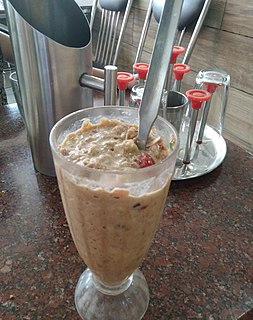 W
WAval Milk or Avil Milk is a Kerala cuisine drink sold in the streets of the Malabar region of Kerala, India. Aval milk is made with aval which is essentially poha or beaten rice flakes, along with ripe bananas, milk of any kind, and nuts.
 W
WSouth Indian cuisine includes the cuisines of the five southern states of India—Andhra Pradesh, Karnataka, Kerala, Tamil Nadu and Telangana—and the union territories of Lakshadweep, Pondicherry, and the Andaman and Nicobar Islands.There are typically vegetarian and non-vegetarian dishes for all five states. Additionally, all regions have typical main dishes, snacks, light meals, desserts, and drinks that are well known in their respective region.
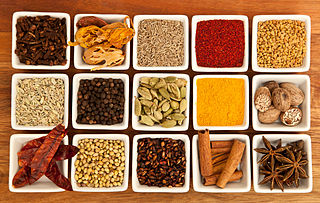 W
WThis is a list of snacks common in South India.
 W
WBanana leaf platter is a traditional method of serving rice dishes in South Indian cuisine. Due to the migration of South Indians, banana leaf rice can also be found in areas with significant ethnic South Indian diaspora such as Malaysia and Singapore.
 W
WCoconut chutney is a Southern Indian chutney-side-dish and condiment, a common in the Indian subcontinent. The condiment is made with coconut pulp ground with other ingredients such as green chillies, tamarind, salt, coriander and water. Coconut chutney is made with both red chillies or green chillies. It is served with dosas, idli, bajji, bonda, and vada. In Karnataka coconut chutney is also served with famous rice dishes such as pulao, puliyogare, tomato bath, vangi bath etc.
 W
WCurd rice, also called yogurt rice, is a dish originating from India. The word "curd" in Indian English refers to unsweetened probiotic yogurt. It is most popular in the South Indian states of Tamil Nadu, Kerala, Karnataka, Telangana and Andhra Pradesh; and also in Maharashtra. In the state of Maharashtra it is known as dahi bhat. In the state of Tamil Nadu it is called thayir saadam, in Kerala it is called tayire chōre and in Telangana and Andhra Pradesh it is called perugannam/daddojanam. In Karnataka, it is called mosaranna. The dish is a staple of traditional cuisine, with the untempered version present at the end of almost every South Indian meal. The tempered version is often served during formal occasions and also offered as prasadam to devotees in temples.
 W
WThe curry tree, Murraya koenigii or Bergera koenigii, is a tropical to sub-tropical tree in the family Rutaceae, and is native to Asia. The plant is also sometimes called sweet neem, though M. koenigii is in a different family to neem, Azadirachta indica, which is in the related family Meliaceae.
 W
WDindigul Thalappakatti Restaurant is a restaurant chain that operates primarily in the Indian state of Tamil Nadu. The first outlet was opened in 1957 at Dindigul. Since then, it operates over 62 outlets in India, seven of which are overseas. The Thalappakatti restaurants focus on biriyani.
 W
WA dosa is a thin pancake or crepe originating from South India, made from a fermented batter predominantly consisting of lentils and rice. It is somewhat similar to a crepe in appearance, although savoury flavours are generally emphasized. Its main ingredients are rice and black gram, ground together in a fine, smooth batter with a dash of salt, then fermented. Dosas are a common dish in South Indian cuisine, but now have become popular all over the Indian subcontinent. Dosas are served hot along with chutney by tradition and sambar in recent times. Other accompaniments include chutney powder.
 W
WIdli or idly are a type of savoury rice cake, originating from the Indian subcontinent, popular as breakfast foods in Southern India and in Sri Lanka. The cakes are made by steaming a batter consisting of fermented black lentils (de-husked) and rice. The fermentation process breaks down the starches so that they are more readily metabolised by the body.
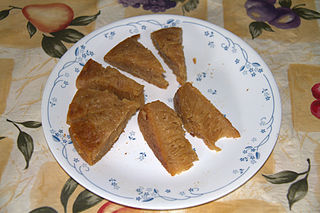 W
WKalathappam (കലത്തപ്പം) is a food from North Malabar and South Malabar, especially Kannur, Malappuram and Kasaragod. It is known as Kalthappa by the Beary Muslims of Mangalore
 W
WKarnataka cuisine includes the cuisines of the different regions and communities of Karnataka, namely, North Karnataka cuisine, South Karnataka cuisine, Udupi cuisine, Saraswat cuisine, Coorg cuisine, Mangalorean Catholic cuisine and Navayath cuisine.
 W
WKootu (Tamil:கூட்டு) is a lentil and vegetable stew in South Indian, particularly Tamil and Kerala cuisines. The etymology for kootu derives from the Tamil word "kootu" which means "add" or "mixture/medley" i.e. vegetable added with lentils form the dish, which is semi-solid in consistency. The dish is noted for its nutty and complex flavors and textures, likely owing to the liberal addition of lentils and coconuts. It is typically less watery than sambhar, but more so than dry stir-fries. Virundhu Sappadu comes with a combination of boiled rice, sambar, rasam, curd, poriyal, kootu, appalam, pickles and banana. All kootus by default have some vegetables and lentils, but many variations of kootu exist:Poricha Kootu: A kootu made with urad dhal and pepper is called poricha kootu. Fried urad dhal, pepper, few red chilies, some cumin and fresh coconut are ground together. Moong dhal and the cut vegetables are cooked separately. Then, the ground paste, cooked vegetables and moong dhal are mixed and heated. Vegetables such as beans and snake gourd are common ingredients in this kootu. Araichivita Kootu: A kootu which has a powdered masala in it; the word araichivita in Tamil literally translates to "the one which has been ground and poured." The ground paste is a mixture of fried urid dhal, cumin seeds and coconut. Araichivita sambar: The chopped vegetables and toor dhal are cooked separately. Then, the ground paste, cooked vegetable and dhal are heated together. Then add the ground paste of coconut, Bengal gram, coriander, red chilies, a few pepper corns, a piece of cinnamon (optionally) - all roasted and ground. Season with mustard seeds and fenugreek seeds. Add the vegetables, including shallots, saute and then add water. Add tamarind extract, and then the ground paste and boiled dal. Served with rice.
 W
WKozhukkattai or kozhukatta is a popular South Indian dumpling made from rice flour, with a filling of grated coconut, jaggery, or chakkavaratti. Kozhukattai, although usually sweet, can sometimes be stuffed with a savory filling. Modak is a similar dish made in other parts of India.
 W
WMasala dosa is a variation of the popular South Indian dosa, which has its origins in Tuluva Udupi cuisine Karnataka. It is made from rice, lentils, potato, fenugreek, ghee and curry leaves, and served with chutneys and sambar. It is popular in South India, it can be found in all other parts of the country and overseas. In South India, preparation of masala dosa varies from city to city. There are variations in Masala dosa like Mysore masala dosa, Rava masala dosa, Onion masala dosa, Paper masala dosa, Cheese masala dosa etc.
 W
WThe Mavalli Tiffin Rooms is the brand name of a food-related enterprise in India. Having its origin in the city of Bangalore, it has a restaurant located on the Lal Bagh Road in Bangalore, ten other branches in the city, one in each of Udupi,Mysuru, Singapore, Kuala Lumpur, and two in Dubai. MTR created the South-Indian breakfast item, rava idli. MTR is a subsidiary of Norwegian conglomerate Orkla ASA.
 W
WMedu vada is a South Indian fritter made from Vigna mungo. It is usually made in a doughnut shape, with a crispy exterior and soft interior. A popular food item in South Indian and Sri Lankan Tamil cuisines, it is generally eaten as a breakfast or a snack.
 W
WButtermilk Kuzhambu or Moru Curry(Malayalam) Mor Kuzhambu(Tamil) is a commonly prepared dish in Kerala and Tamil Nadu. This is a liquid curry recipe which is served with white or boiled rice, pancake made of lentils / mixed gram dosa.
 W
WPakora is a spiced fritter originating from the Indian subcontinent, sold by street vendors and served in restaurants in South Asia and worldwide. It consists of items, often vegetables such as potatoes and onions, coated in seasoned gram flour batter and deep fried.
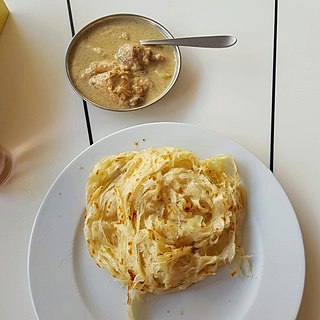 W
W'Parotta or Porotta is an Subcontinental layered flatbread made from Maida or Atta, alternatively known as flaky ribbon pancake. It is very common in Kerala, Tamil Nadu and widely available in other states like Karnataka, Maharashtra and countries like Malaysia, United Arab Emirates and Sri Lanka.
 W
WVazhakkappam or Pazham pori also known as ethakka appam and Bekachi is a fritter food with ripened banana or plantain and maida flour. A popular food item in South Indian cuisines, especially in Kerala, it is generally eaten as a breakfast or a snack. It is called as Balekayi bajji in Kannada, Vazhakkay bajji in Tamil, and Aratikaya bajji in Telugu.
 W
WDahi chutney is strained dahi that is mixed into a chutney of mint and onions, originating from the Indian subcontinent. It is popular in South India and is a side dish along with Mirchi ka salan for the popular Hyderabadi biryani.
 W
WPoduthol is a South Indian North Malabar side dish. It is generally served with cooked rice at lunch and dinner. It is customarily served in celebration of weddings and other ceremonies.
 W
WPulihora, also known as puliyogare, puliyodarai,pulinchoru, kokum rice, or simply tamarind rice, is a very common and traditional rice preparation in the South Indian states of Karnataka, Andhra Pradesh, Telangana, Kerala and Tamil Nadu. Puli means 'tangy' or 'sour' in South Indian languages, referring to the characterizing use of kokum or tamarind as one of the main ingredients.
 W
WPunugulu or Punukkulu is a snack and common street food in Vijayawada and a few coastal districts of Andhra Pradesh. Punugulu is a deep fried snack made with rice, urad dal and other spices. They are often served with peanut chutney, known as palli chutney, coconut chutney, verusanaga chutney or toordal chutney known as Kandhi Pachadi, or they can be served with capsicum peanut chutney. They are also very popular in Hyderabad.
 W
WRasam is a clear and spicy South Indian soup. It is eaten with rice or consumed as a soup. In a traditional South Indian meal, it can be part of a course that includes sambar rice and curd rice. Rasam has a distinct taste in comparison to the sambar due to its own seasoning ingredients and is fluid in consistency. Chilled prepared versions are marketed commercially as well as rasam paste in bottles.
 W
WRice and curry is a popular dish in Sri Lanka, as well as in Indian Subcontinent and Bangladesh.
 W
WSambar is a lentil-based vegetable stew/soup, cooked with pigeon pea and tamarind broth. It is popular in South Indian and Sri Lankan cuisines.
 W
WA samosa is a South Asian fried or baked pastry with a savory filling like spiced potatoes, onions, peas, chicken and other meats, or lentils. It may take different forms, including triangular, cone, or half-moon shapes, depending on the region. Samosas are often accompanied by chutney, and have origins in medieval times or earlier. Samosas are a popular entrée, appetizer, or snack in the local cuisines of South Asia. Due to emigration and cultural diffusion from these areas, samosas today are often prepared in other regions.
 W
WSaraswat cuisine is the cuisine of the Saraswat Brahmins from the Konkan region on the western coast of India. Saraswat cuisine differs within the Saraswat Brahmin subsects and within the Konkan-Canara region. Saraswat cuisine originally hails from the Konkan region including Uttara Kannada, Udupi district, Dakshina Kannada, Damaon, and Goa, India. Saraswat cuisine is popular served in many restaurants throughout the western coast of India, and especially in the cities of Bombay and Bangalore. Each variation has its unique flavour and makes uses of different vegetables and fruits available in the region. Saraswat cuisine is usually pesco-vegetarian, except acharyas and purohits who follow a strictly saatvik vegetarian diet. According the Saraswat folklore, fish meats are regarded as sea vegetables. Historically, they have refrained from eating any terrestrial animals in general.
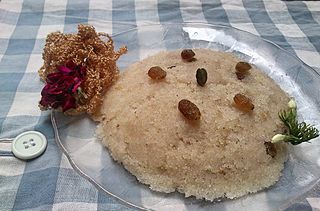 W
WSuji ka halwa is a type of halvah made by toasting common-wheat semolina in a fat like ghee or oil, and adding a sweetener like sugar syrup or honey. It can be served for breakfast or as a dessert item. The basic recipe is made with just semolina (farina), sugar or honey, ghee, and sometimes milk. Variations on this include dried or fresh fruits, nuts, shredded coconut, and other toppings.
 W
WTamil cuisine is a culinary style originating in the southern Indian state Tamil Nadu and other parts of South Asia like Sri Lanka. Both Vegetarian cuisine and Non-Vegetarian cuisine is popular among the Tamil people and has been since ancient times. However, meats along with rice, legumes and lentils are also popular. Dairy products and tamarind are used to provide sour flavors. On special occasions, traditional Tamil dishes are served in a traditional manner, using banana leaves in place of utensils. After eating, the banana leaves are then used as a secondary food for cattle. A typical breakfast meal consists of idli or dosa with chutney. Lunch includes Rice, sambar, Curd, kuzhambu, and rasam.
 W
WTelangana cuisine is a food culture unique to Telangana Region. The Telangana state lies on the Deccan plateau and its topography dictates more millets and roti based dishes. Jowar and Bajra features more prominently in their cuisine. Due to its proximity with Maharashtra, Chhattisgarh and northwest Karnataka, it shares some similarities and differences of the Deccan Plateau cuisine.
 W
WTelugu cuisine is a cuisine of South India native to the Telugu people from the states of Andhra Pradesh and Telangana. Generally known for its tangy, hot and spicy taste, the cooking is very diverse due to the vast spread of the people and varied topological regions.
 W
WThalassery cuisine refers to the distinct cuisine from Thalassery town of northern Kerala, which has blended in Arabian, Persian, Indian and European styles of cooking as a result of its long history as a maritime trading post.
 W
WTheeyal is a South Indian dish originating from the Indian state of Kerala. It has a soupy consistency, and is made from a mixture of spices consisting of roasted coconut, coriander seeds, dried red chili and fenugreek. All spices are ground to a paste and cooked in tamarind water with vegetables. When completed it looks like a rich medium brown gravy and is normally served with rice.
 W
WThoran (Malayalam: തോരൻ, pronounced [t̪oːɾan]; or upperi in Northern Kerala is a class of dry vegetable dishes combined with coconut that originated in the Indian state of Kerala. This common dish is usually eaten with rice and curry and is also part of the traditional Keralite sadhya.
 W
WUpma, uppumavu or uppittu is a dish originating from the Indian subcontinent, most common in Kerala, Andhra Pradesh, Tamil Nadu,Karnataka, Maharashtrian, Gujarat, Odia and Sri Lankan Tamil breakfast, cooked as a thick porridge from dry-roasted semolina or coarse rice flour. Various seasonings and/ vegetables are often added during the cooking, depending on individual preferences. Today it is popular in most parts of India and is prepared in various ways.
 W
WUpsaaru, also known as Uppesaru, a kind of sambar in South India mainly in southern part of Karnataka state. It is a traditional food of South Karnataka.
 W
WUthappam is a type of dosa from South India. In Tamil Nadu it is known as Uthappam (ஊத்தப்பம்), in Karnataka it is known as Uttappa (ಉತ್ತಪ್ಪ). In Kerala it is known as Oothappam (ഊത്തപ്പം) In Tulu it is known as Ootappa (ಊತಪ್ಪ) or Ootappo ( ಊತಪ್ಪೊ). Unlike a typical dosa, which is crisp and crepe-like, uttapam is thicker, with toppings. The name is derived from the Tamil words Appam and Utthia or Uttria, meaning Poured-Appam. Because Appam is cooked on a round bottom pan, whereas Utthia-Appam is cooked on a flat skillet. The Tamil ancient literature have a mention of it by its name. The classic breakfast of the Tamil residents consists of idli, dosai or uttappam mostly accompanied by sambar and chutney.
 W
WVada [vəɽɑː] or bada [bəɽɑː] is a category of savoury fried snacks from India. Different types of vadas can be described variously as fritters, cutlets, doughnuts, or dumplings. Alternative names for this food include wada, vade, vadai, wadeh and bara.